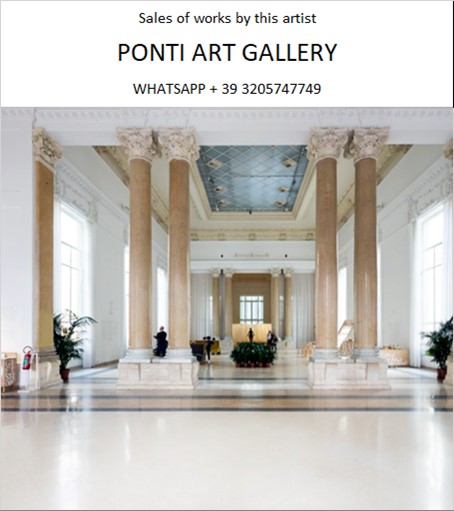Ponti Art Gallery is interested in buying and selling works
of art by this artist.

George Wesley-Bellows Biography
George Wesley Bellows was an American realist painter, celebrated for his powerful depictions of urban life in New York City. Born on either August 12 or 19, 1882, in Columbus, Ohio, Bellows was raised in an atmosphere of political conservatism and religious piety. His father was a building contractor, and his mother hoped he would become a Methodist bishop. Despite this, Bellows showed an early talent for drawing, which was encouraged by his teachers and his aunt, who nurtured his artistic inclinations.
Bellows' athletic abilities were equally notable, and he excelled in baseball and basketball, playing semiprofessionally for years. He attended The Ohio State University from 1901 to 1904, where he was a star athlete and provided illustrations for the school's yearbook, the Makio. Despite a promising future in sports, Bellows' passion for art prevailed. He left university without graduating and moved to New York City in 1904 to pursue his artistic ambitions.
In New York, Bellows became a student of Robert Henri, a leading figure in the Ashcan School of American realism. Henri's influence was profound, and Bellows quickly absorbed his mentor's philosophy that art should be an honest reflection of life. He became known for his vibrant and gritty portrayals of New York City's tenements, streets, and its inhabitants. His early works, such as "Forty-Two Kids" (1907), a depiction of street children swimming in the East River, and "Cliff Dwellers" (1913), which captured the crowded tenements of the Lower East Side, were characterized by their vitality and unvarnished view of urban life.
Bellows' reputation grew rapidly, and by 1909, he was elected an associate member of the National Academy of Design, achieving full membership by 1913. He also taught at the Art Students League in New York and contributed illustrations to the socialist magazine "The Masses." His involvement with the Armory Show of 1913, which introduced European modernist art to the American public, marked a turning point in his career. Although he remained a realist, Bellows began to experiment with color and composition, reflecting a modernist sensibility.
One of Bellows' most enduring legacies is his series of boxing paintings, such as "Stag at Sharkey's" (1909) and "Both Members of This Club" (1909). These works captured the raw energy and brutality of the sport, which was illegal at the time and conducted in private clubs. His ability to convey movement and emotion on canvas was unmatched and contributed to his standing as one of the most acclaimed American artists of his generation.
Bellows also explored other themes in his work, including landscapes, seascapes, and war scenes. His war paintings, which depicted the atrocities of World War I, were particularly poignant and reflected his complex views on the conflict. Despite his support for American intervention, his work criticized the censorship and persecution of dissenters under the Espionage Act.
In addition to painting, Bellows made significant contributions to lithography, helping to establish it as a fine art form in the United States. He produced nearly 200 lithographs, which often carried a more satirical tone than his paintings. His portraits, whether commissioned or of family and friends, were marked by his keen observation and ability to capture the unique character of his subjects.
Bellows' life was tragically cut short when he died of appendicitis on January 8, 1925, at the age of 42. His death was a great loss to the art community, and his teacher, Robert Henri, was particularly affected. Bellows was survived by his wife, Emma Story Bellows, and their daughters, Anne and Jean. After his death, Emma played a crucial role in preserving his legacy, organizing exhibitions and collaborating on a catalogue raisonné of his work.
Today, Bellows is remembered as a quintessential American artist, whose work captured the spirit of his times with boldness and authenticity. His paintings are held in major museums across the United States, and his influence on American art remains profound. His depictions of New York City and American life continue to resonate with viewers, reflecting the vitality, struggles, and complexities of the early 20th century.
George Wesley-Bellows Quotes
and Sales of Works
Ponti Art Gallery selects and deals with paintings by the
artist. Upon request, we provide free estimates and
evaluations, communicate prices, quotations, and current
market values.
If you are interested in BUYING or SELLING works by the
artist, contact us immediately.
If you wish to sell or receive an evaluation of the
works:
Send us a frontal photo of the painting, one of the back,
and one of the signature. Also, indicate the dimensions of
the work. Inform us about the purchase origin of the work
and any kind of available documentation (purchase
receipts, certificates of authenticity, publications). One
of our operators will respond to you on the same day. We
guarantee maximum confidentiality and extreme
professionalism.
If you wish to purchase works by the painter: Contact us
and let us know your request. We will inform you about the
available works. We also offer the possibility to
subscribe to our NEWSLETTER, through which you will be
informed at the beginning of each month about the latest
acquisitions of the art gallery.
You can send us pictures of the work:
